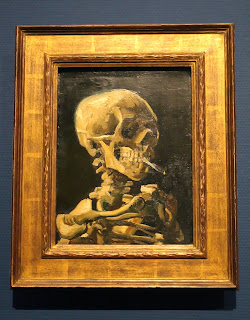 |
| The "Yellow House" in Arles where Vincent van Gogh lived in 1888 |
_-_02.jpg) |
| Portrait of Theo van Gogh, 1887, by Vincent Portrait of Johanna van Gogh-Bonger, 1905,
by Johan Cohen Gosschalk hfyfyfyfyfyfyfyfyf
|
 |
| Self Portrait, 1887 |
The van Gogh Museum is the most visited museum in the Netherlands, and it's easy to see why. Theo and Johanna's wish for Vincent's work to be valued by the public as they valued it came true. Thanks to them we can be immersed in the amazing artwork and thought of this uniquely talented man. I loved every minute of the two hours I spent there. The time went by fast...
 |
| Vincent's palette! |
We were able to take photos (without a flash) and I photographed some of Vincent's works that I found most interesting. This is a great advantage when visiting a museum, because when I'm home I can review the artworks that were of particular interest, and learn more about them and the circumstances of the artist's life when he or she created them.
Many of Vincent's letters were on display (as well as his oil palette and tubes of paint!) I hadn't seen his letters before, or known about the beautiful little sketches that he added to some of them. And I'd seen very few of Vincent's drawings and watercolors until now. At first he struggled with drawing, particularly with issues of perspective in his paintings. But his hard work and determination to improve his artistic skills paid off.
 |
| A few of Vincent wonderful drawings . |
 |
| Detail from Still Life with Red Cabbages and Onions, 1887 |
There was another painting from Vincent's "Paris period" (1886-88) that I especially loved, Still Life with Red Cabbages and Onions, painted with his legendary yellows, oranges and reds. The warm colors were enhanced with a good dose of complementary lavenders and blues. I could have stared at that painting for hours! I found its rhythmic brushstrokes and soothing colors mesmerizing…
Which brings me to something I discovered this morning, reading Johanna's sensitive memoir about her famous brother-in-law. Check it out: http://www.vggallery.com/misc/archives/jo_memoir.htm.
Vincent and I have "a moment" in common! In her memoir Johanna often quotes from Vincent's letters. Here is an excerpt telling of an incident during a visit that Vincent made to the Rijksmuseum with a friend. It describes Vincent's reaction to a painting by Rembrandt:
Vincent could not tear himself away from the "Jewish Bride" and said at last, "Would you believe it...I should be happy to give ten years of my life if I could go on sitting here in front of this picture for a fortnight, with only a crust of dry bread for food?"
Like Vincent, I was struck by the beauty of that particular painting by Rembrandt! I could have stared at The Jewish Bride all day, drinking in in the luscious details of Rembrandt's masterful use of paint. But I had an advantage that Vincent didn't have: a great camera.  |
| Head of a Skeleton with a Burning Cigarette, (1886) |
p.s. Vincent had a sense of humor. He added a cigarette to this study of a skeleton, most likely painted when he was studying at the Art Academy in Antwerp :-)


No comments:
Post a Comment